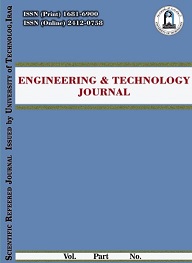Abstract
An experimental study is conducted on the utilization of water atomization to
evaluate its impact on the humidification of steadily flowing air travelling
throughout a curved portion of a uniform cross sectional duct. One of the more
interesting aspects of curved channel flows is the introduction of a secondary flow
pattern in the duct cross-section. The naturally generated turbulences in air flow
will certainly assist the mixing between the air and the injected water droplets and
improve the heat and mass transfer process encountered in evaporative cooling of
the incoming air drought.
The present study is considered as a simulation of the gas turbine inlet air
cooling by the fogging technique. The drier the air, the better the humidification
and cooling process. At higher ambient temperature of 43oC, an increase in the
relative humidity of 67.8% and a temperature reduction of 39.6% were recorded at
higher water atomizer rate of 24.2ml/s. Generally, the lower half of the curved duct
is shown to be less sensitive to the atomizer position for a range of inclination
angles between 10o to 45o with radial locations between 5 to 20cm from the inner
wall. This situation makes this region most suitable for using atomizing array
across it in order to give acceptable performance for cooling system. Nevertheless,
the upper half of the curved duct introduces a critical atomizer position suitable for
single point spray. This position is considered as the optimum atomizer position
defined by a radii ratio of (r/rin = 3.2) and an orientation of -10o to the tangential
flow.
evaluate its impact on the humidification of steadily flowing air travelling
throughout a curved portion of a uniform cross sectional duct. One of the more
interesting aspects of curved channel flows is the introduction of a secondary flow
pattern in the duct cross-section. The naturally generated turbulences in air flow
will certainly assist the mixing between the air and the injected water droplets and
improve the heat and mass transfer process encountered in evaporative cooling of
the incoming air drought.
The present study is considered as a simulation of the gas turbine inlet air
cooling by the fogging technique. The drier the air, the better the humidification
and cooling process. At higher ambient temperature of 43oC, an increase in the
relative humidity of 67.8% and a temperature reduction of 39.6% were recorded at
higher water atomizer rate of 24.2ml/s. Generally, the lower half of the curved duct
is shown to be less sensitive to the atomizer position for a range of inclination
angles between 10o to 45o with radial locations between 5 to 20cm from the inner
wall. This situation makes this region most suitable for using atomizing array
across it in order to give acceptable performance for cooling system. Nevertheless,
the upper half of the curved duct introduces a critical atomizer position suitable for
single point spray. This position is considered as the optimum atomizer position
defined by a radii ratio of (r/rin = 3.2) and an orientation of -10o to the tangential
flow.
Keywords
curved duct; atomizer; fogging system; inlet air cooling; humidification.
